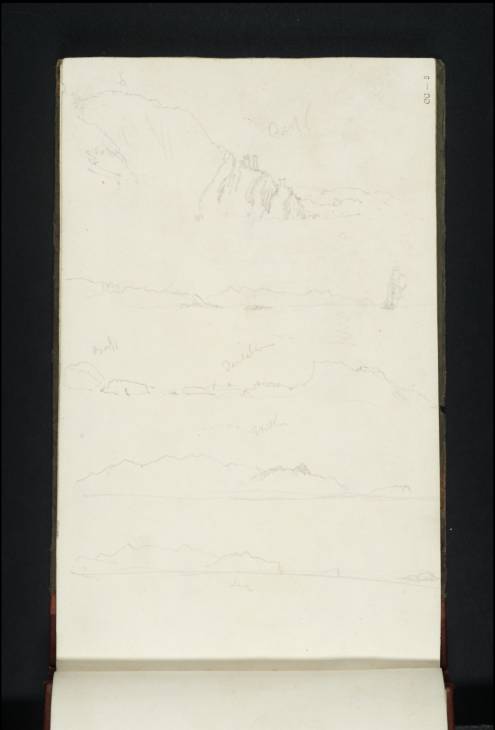Joseph Mallord William Turner Sketches of the East Lothian Coast: Fast Castle, Bass Rock, Tantallon Castle, Criagleith and Lamb 1822
Image 1 of 2
Joseph Mallord William Turner,
Sketches of the East Lothian Coast: Fast Castle, Bass Rock, Tantallon Castle, Criagleith and Lamb
1822
Joseph Mallord William Turner 1775–1851
Folio 5 Recto:
Sketches of the East Lothian Coast: Fast Castle, Bass Rock, Tantallon Castle, Criagleith and Lamb 1822
D17516
Turner Bequest CC 5
Turner Bequest CC 5
Pencil on white wove paper, 187 x 114 mm
Inscribed in pencil by Turner ‘Fast’ centre top, ‘Bass’ centre left, ‘Tantallon’ centre, ?‘Craigleith’ lower centre, ?‘lam’ bottom centre
Stamped in black ‘CC 5’ top right running vertically
Inscribed in pencil by Turner ‘Fast’ centre top, ‘Bass’ centre left, ‘Tantallon’ centre, ?‘Craigleith’ lower centre, ?‘lam’ bottom centre
Stamped in black ‘CC 5’ top right running vertically
Accepted by the nation as part of the Turner Bequest 1856
References
1909
A.J. Finberg, A Complete Inventory of the Drawings of the Turner Bequest, London 1909, vol.I, p.610, CC 5, as ‘“Fast Castle,” the “Bass” Rock, “Tantallon.”’.
1981
Gerald Finley, Turner and George the Fourth in Edinburgh 1822, exhibition catalogue, Tate Gallery, London 1981, pp.81, [97] reproduced as ‘“Fast Castle”, “Bass” Rock, “Tantallon”’.
This page, used with the sketchbook turned to the left, contains the first images that Turner made in Scotland on this occasion. The East Lothian coastal subjects were all familiar to the artist and he was no doubt keen to see at least one of them, Bass Rock, as he was still due to paint a watercolour of it for the Provincial Antiquities and Picturesque Scenery of Scotland publication: Bass Rock, circa 1824 (National Museums and Galleries on Merseyside).1 Fast Castle and Tantallon Castle were also Provincial Antiquities subjects, though Turner was not commissioned to paint Fast Castle, and his painting of Tantallon, 1821 (Manchester City Art Galleries)2 had been published in the sixth number of the publication just a month before.
At the top of the page is a sketch inscribed ‘Fast’ showing the few remaining ruins of the castle perched precariously on the steep cliff edge of Fast Castle Head. Turner first drew the castle in 1801, and returned in 1818 to make a few more rough sketches.
The sketch beneath shows an indistinctive stretch of rocky coastline, presumably somewhere along the coast between Fast and Tantallon Castles. Despite the lack of topographical specificity the scene has more of a sense of atmosphere that the others, with the dark boat and the reflection of the low sun on the water.
The third sketch is again identified by its inscriptions: ‘Bass’ Rock and ‘Tantallon’ Castle. With the island on the left and the castle on the right, Turner must have made this sketch from the west after having sailed between the two places. There are further sketches of Bass Rock on folio 7 verso and of the Bass and Tantallon Castle on folio 8, made during his outward voyage, and on folios 78 verso, 79, 79 verso, made on his return (D17521, D17522, D17645, D17646, D17647).
The second-from-bottom sketch may be inscribed ‘Craigleith’, as the long ragged shape matches that of the island. Below this is ‘Lam[b]’, a slightly smaller island to the west of Craigleith. These two islands may appear again on folios 7 verso, 8 and 78 verso.
Technical notes:
There are two small holes at the top left of the page.
There are two small holes at the top left of the page.
Thomas Ardill
July 2008
How to cite
Thomas Ardill, ‘Sketches of the East Lothian Coast: Fast Castle, Bass Rock, Tantallon Castle, Criagleith and Lamb 1822 by Joseph Mallord William Turner’, catalogue entry, July 2008, in David Blayney Brown (ed.), J.M.W. Turner: Sketchbooks, Drawings and Watercolours, Tate Research Publication, December 2012, https://www


